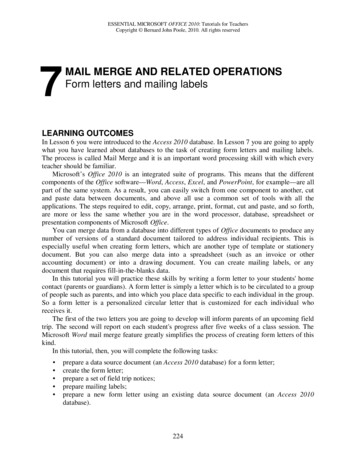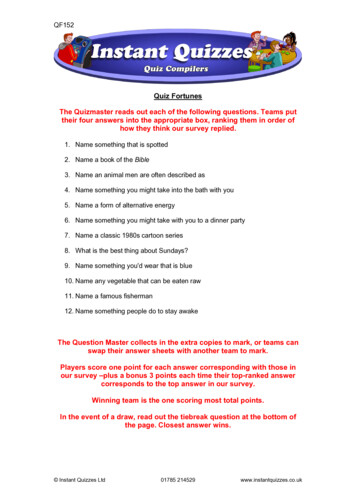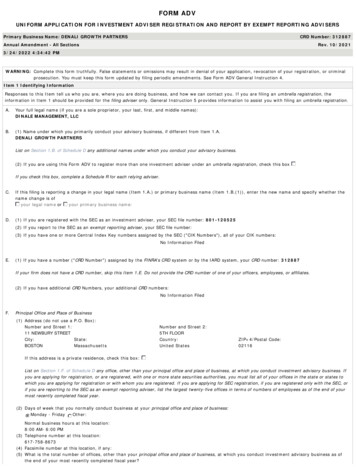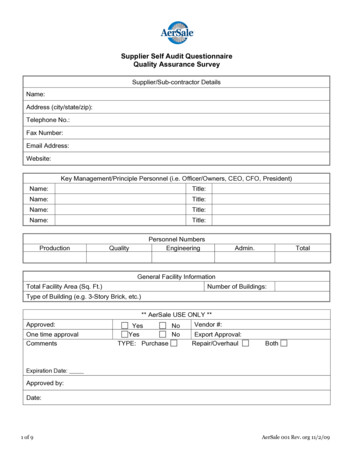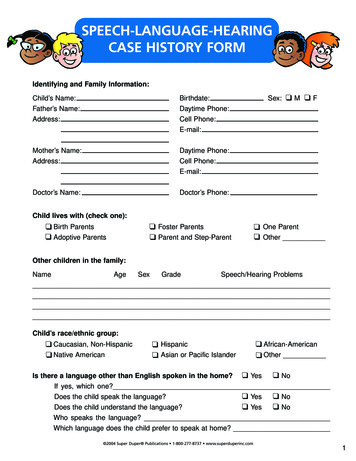![What's In A Name? Book Of Mormon Language, Names, And [Metonymic] Naming](/img/33/whats-in-a-name-book-of-mormon-language-names-and-metonymic.jpg)
Transcription
Journal of Book of Mormon StudiesVolume 3 Number 1Article 21-31-1994What's in a Name? Book of Mormon Language,Names, and [Metonymic] NamingGordon C. ThomassonBroome Community College, in Binghampton, New YorkFollow this and additional works at: https://scholarsarchive.byu.edu/jbmsBYU ScholarsArchive CitationThomasson, Gordon C. (1994) "What's in a Name? Book of Mormon Language, Names, and [Metonymic] Naming," Journal of Bookof Mormon Studies: Vol. 3 : No. 1 , Article 2.Available at: is Feature Article is brought to you for free and open access by the All Journals at BYU ScholarsArchive. It has been accepted for inclusion in Journalof Book of Mormon Studies by an authorized editor of BYU ScholarsArchive. For more information, please contact scholarsarchive@byu.edu,ellen amatangelo@byu.edu.
Title What’s in a Name? Book of Mormon Language,Names, and [Metonymic] NamingAuthor(s) Gordon C. ThomassonReference Journal of Book of Mormon Studies 3/1 (1994): 1–27.ISSN 1065-9366 (print), 2168-3158 (online)Abstract Anthropological perspectives lend insight on namesand on the social and literary function of names inprinciple and in the Book of Mormon. A discussionof the general function of names in kinship; secretnames; and names, ritual, and rites of passage precedesa Latter-day Saint perspective. Names and metonymyare used symbolically. Examples include biblical andBook of Mormon metonymic naming, nomenclature,and taxonomy. Biblical laws of purity form the foundation for a pattern of metonymic associations withthe name Lamanite, where the dichotomy of clean/unclean is used to give name to social alienation andpollution.
What's in a Name?Book of Mormon Language, Names,and [Metonymic] NamingGordon C. ThomassonAbstract: Anthropological perspectives are presented on names,and on the social and literary function of names, in principle and inthe Book of Mormon. The function of names in kinship; secretnames; and names, ritual, and rites of passage are first discussed ingeneral and then from a Latter-day Saint perspective. The symbolicuse of names and metonymy or metonymic naming are thendiscussed. Examples are given of biblical and Book of Mormonmetonymic naming, nomenclature, and taxonomy. Finally, it issuggested that biblical laws of purity form the foundation for apattern of metonymic associations with the name Lamanite, wherethe dichotomy of clean/unclean is used to give name to socialalienation and pollution.IntroductionWhat's in a name? On occasion the name or title Doctor hasbeen incorrectly ascribed to me-not as a conferred Ph.D.,! but asIn 1987 Gordon Conrad Thomasson completed a Ph.D. at CornellUniversity, where his dissertation was based upon fieldwork among the Kpelle ofWest Africa. His first or given name is shared by his paternal grandfather and atleast six of that ancestor's descendants, and his middle name is his mother'smaiden surname, which was chosen from among a number of given names common to his maternal grandfather's family to replace their German-speakingSwiss family name of Kunz. which they were told would hinder their social acceptance in America. Thomasson, or the son of Thomas, is not, in this case,
2JOURNAL OF BOOK OF MORMON STUDIES 3/1 (SPRING 1994)an M.D. or physician. I am an interdisciplinary social scientist, anapplied anthropologist, and a historian among other things, butnot a medical doctor (though for some the confusion may havearisen because I have done research on and taught medicalanthropology in a B.S.lR.N.-degree-granting college of nursing).The confusion is natural. Everyone from plant physiologists todoctors of philosophy in theater arts is as likely to .hear garruloushypochondriacs begin a long recitation of their symptoms onhearing the title doctor at a party, since the majority of the population, outside the academic community, first think of medicalpractitioners when they hear that name or title.Like names or titles in less secular societies, in our culture thetitle doctor, whatever academic field its origin, usually signifiesthat the bearer has indeed undergone certain rites of passage. 2And the name doctor (as well as certain vestments, oaths, andcovenants) both symbolizes and in some ways teaches the individual and the community what that particular person's role in society is to be and what skills, abilities, or authority that individuallegitimately can be expected to exercise. It also structures therelationships such an individual has with the rest of the community.3 So titles that are mistaken for that of the M.D. are quitelegitimately confused, from a social point of view.Scandinavian. The earliest known ancestor at this time is George Thomason, amember of the stationer's guild and the London Common Council at the outset ofthe Long Parliament. He was a social and economic radical and a friend of JohnMilton (whose Sonnet XIV was dedicated to the memory of Thomason's deceasedwife), but he also rebelled against Cromwell's excesses in mid seventeenthcentury England. There is some suggestion that before this the family name wasfrom. Scotland, coming from identification as descendants of one Thomas, son ofa chief of one of Scotland's outlawed or broken clans, the MacFarlanes.2A pattern I have seen occasionally in nineteenth-century genealogies,where Doctor was a given name bestowed at birth, is repeated in my own ancestryin a son of my third-great paternal grandfather, named Doctor Alfred Thomasson(b 1818, York Dist., SC, d 28 Nov 1850, York Co SC).3While in today's relativistic/nihilistic ethical climate many peopleseem to think that taking a name one has not really earned is either trivial or nooffense at all, most would still draw the line when it came to having a braintumor removed by someone who obtained the name/title of doctor or M.D.through the mail from a diploma mill, or by sending in three UPC symbolsclipped from a comic book or cereal box and 15.00 plus 3.95 for shipping and
THOMASSON, WHAT'S IN A NAME?3KinshipNames, first of all, can, and I stress the conditional, tell usabout kinship. Any Balinese, upon learning that my oldest son isnamed after his maternal great-grandfather, would smile and nodknowingly. How else should he be named, since from their pointof view great-grandfathers are reincarnated as great-grandsons?But in our modem and increasingly secular and socially fragmented world, kin relationships are rarely reflected in anythingexcept last names. Generations live far apart in space, time, andworld view. As a result, in 1984 when this study was first presented, I knew of several thirteen-to-seventeen-year-old Raquelsand many more two-to-seven-year-old Brookes and Farrahs. Suchnames tell us nothing specific about the genealogy of suchindividuals, however much they reflect the fragmentation offamilies in our society and the media tastes of these children'sparents-just as Jared Mahonri Moriancumr Jones's name reflectshis parents' religion. Many are glad for a world where no onesays, "Oh, you're a son of xxxx, aren't you?" or "You're thatso-and-so's son!" In our society today, children rarely suffer forthe sins of their parents, at least in name.Secret NamesAn elementary point learned along the fieldwork-path tobecoming an anthropologist is that names are often not what theyseem to be, either for the person who bears them or for the rest ofsociety. Among the KpeUe of West Africa with whom I worked, ina pattern found in many areas which experience a high infantmortality rate, naming serves a talismanic function: protectingchildren from evil. Boys are given names such as good fornothing or dirt, for example, so that they will be beneath thenotice of the powers of death-unattractive targets, as it were.handling. Only when confronted with such criminal misappropriation of namesdoes society appear to recognize that names do have meanings. Texts such as theGospel of Philip are, on the other hand, eloquent on the sin of usurping or takinga name at interest (cf. James M. Robinson, ed., The Nag Hammadi Library inEnglish [New York: Harper and Row, 1977], 139, II, 3, 65, 24-31).
4JOURNAL OF BOOK OF MORMON STUDIES 311 (SPRING 1994)Upon reaching the age where they are initiated into the secretmen's Poro society, these boys will be given " manly" namessuch as Leopard, that reflect their real worth to society. This fact,that people's names change through time, is a bane to the superficial genealogist. It should not be surprising to us as Latter-daySaints, if we carefully examine the entire complex of our rituallife, and this may provide some suggestions for future Book ofMormon investigations as well.Names and Ritual: Rites of PassageNames can be acquired by legitimate means, through ritual.With the objective of their sons being legitimate descendants ofAbraham and thereby partakers of the Abrahamic covenant, Jewsand MosJems still practice circumcision. 4 If we carefully studyArnold Van Gennep's pioneering classic work, Rites of Passage,5we will find a pattern of ritual name-giving associated with transitions to specific life stages that has familiar resonances within theLatter-day Saint religion. Linked with each of these passages is theusually gradual (line upon line, precept upon precept) pattern ofteaching and reception of certain knowledge appropriate to thatage, the making of covenants, explicit or implied, with the largersociety, and the receiving of a new name. In this light, if we examine Latter-day Saint practices we will find that:1. Upon making the transition from pre-earth life or the"spirit world" to mortality, the first thing we ritually give aninfant is a "name" by which that child will be known, except incases of bad health where the child may first be anointed andblessed to be healed.2. As a child grows, the next transition we find it making isbeing baptized. Associated with certain covenants which the child(or the adult as pseudochild) makes is the taking upon oneself the4See my entry on "Circumcision" in the Encyclopedia of Mormonism. 4vols. (New York: Macmillan, 1992). 1:283. That such ritually acquired lineageand names (bar or ben Abraham/Ibrahim) can be lost is eloquently described inJohn 8:31-44 (compare the outrage exhibited when Christ proclaims his lineageand name: John 5:18. 10:30-38). The prayer formula "God of our Fathers.Abraham. Isaac. and Jacob" reflects this pattern.5Arnold Van Gennep. Rites of Passage (Chicago: University of ChicagoPress, 1960).
THOMASSON, WHAT'S IN A NAME?5name of Christ, or, properly speaking, becoming a Christian inname, and, it is to be hoped, in behavior.3. The next name assumed and given is that of Brother orSister, as' the newly baptized Christian is also confirmed a memberof the institutional Church, entering into a theologically not-sofictive kinship relationship with others who have made the samecovenants tobe willing to mourn with those that mourn; yea, andcomfort those that stand in need of comfort, and tostand as witnesses of God at all times, and in all things,and in all places that they may be in, even until death.(Mosiah 18:9)This named kin-relationship is reciprocally assumed and madeeven less "fictive" by the local congregation accepting the newmember through the process of common consent (a type ofadoption).4. The next specific naming takes place approximately atpuberty for boys, when our society splits what had been sexuallyundifferentiated patterns of childhood socialization (the Primaryprogram prior to the BlazerlMerrie Miss age) into specific sexually differentiated associations or societies for socialization ofyouth into their future roles as adults. 6 Boys at approximatelytwelve years of age are ordained and given the name of deacons,. with a set of scripturally mandated responsibilities and roles thatgive them their place within society. At the same time that boysare learning their roles as both future fathers and priesthood holders, girls are instructed in the roles they will fill. Ordination as ateacher and finally a priest gives the boy more roles, and teacheshim more of society's expectations, to say nothing of conferringupon him new names.5. At some point in this phase of preadulthood, both sexeshave the opportunity to take upon them not just their personalname, but their tribe's name as well, through what we call6 Karen Cammack Parker (in the course on Mormon Society and Culture Itaught at BYU in 1983-Anthropology 346) first noted and discussed this, infact, rather predictable pattern of age/sex segregation as it manifests itself inMormon culture and compared it to non-European societies.
6JOURNAL OF BOOK OF MORMON STUDIES 3/1 (SPRING 1994)"patriarchal" blessings, which affirm the person's lineage andgive further instruction as to how that individual is to live.6. As the men and women enter adulthood they are reintegrated socially' in the Gospel Doctrine class of the Sunday School.At about this time, men, if willing and able to live the covenantsand fill the expected roles, are given the name of Elder-anappropriate title for an adult within any social system. From thispoint onward it is also appropriate--other rites of passage such asmissions being preferred but not absolutely required-that thoseentering marriage do so in a context wherein they also receivemore names, based upon new covenants, learned roles, and expectations, including receiving through ritual the names of husbandor wife, and later, mother or father. All these names condition theindividual's social relationships and other people's expectationsof them.7. Progressing in age, men and women can gain other names.Through auxiliary and priesthood callings names such asPresident and Bishop are acquired. The degree to which suchnames structure social relationships and role expectations can beimagined if one pictures the reactions in a bar if the bartenderwere to say "Why, hello, Bishop," depending on if he wasaddressing him as a customer or a visitor.These patterns are not new or unique to Latter-day Saints. Butsome, upon examining Latter-day Saint temple worship, thinkthey find a discontinuity between it and the rest of the gospel. 7From an anthropological perspective, there is none. The problemis, and this brings us directly back to the Book of Mormon, thatthese patterns of public ritual and culture are the water in whichwe, like fishes, swim. They are so commonplace as to be invisibleto us normally, and we take them for granted until confronted bysomething as dramatic and personally revealing as the Latter-daySaint temple experience. 87Compare the following citations from the Coptic, Gnostic (so-called)Gospel of Philip, in Robinson, ed., The Nag Hammadi Library in English, 133,11,3,54,5-13; 137, II, 3, 61, 20-35; 140-41, II, 3, 67, 19-38, and 68, 1-17.8 We have not yet even begun to explore carefully the possibility of patterns of ritual naming in the Book of Mormon, though I am reasonably certain,based upon their commonplaceness in other cultures, that we will find some, andI commend this study to those whom it interests.
THOMASSON, WHAT'S IN A NAME?7Not Quite a Digression: On Taking the Book ofMormon for GrantedAn example of how we take things for granted is found in ourown unconscious goyische cultural bias (gentile American, as con- trasted to Latter-day Saint), having led to our missing the fact ofIsraelite worship, festival, and holy day observances in the Book ofMormon. For some time there has been a widespread awareness ofthe ancient nature of events described in Mosiah 1-6. 9 In thesummer of 1984 I discovered that there was a second divine kingship allusion (Alma 20:9-12) in the Book of Mormon. A fewweeks later I discovered a rather clear reference to the Rosh haShanah through Yom Kippur "days of penitence (or awe)"(Alma 30:2-4), and after that I recognized that Alma 36-42reflected a Passover ritual. lOWhat does this have to do with language in general and namesin particular? I mention this revolution in approach to the Book ofMormon because it suggests why we previously may have missedobvious dimensions of the scriptures' meanings. One reason is9See, for example, lesson XXIII, "Old World Ritual in the New World" inHugh Nibley, An Approach to the Book of Mormon (Salt Lake City: The Councilof the Twelve Apostles of the Church of Jesus Christ of Latter-day Saints, 1957),256-70; reprinted in CWHN 6:295-310; John A. Tvedtnes, "The Nephite Feastof Tabernacles" in Tinkling Cymbals: Essays in Honor of Hugh Nibley, ed. JohnW. Welch (Los Angeles: no pub., 1978), 145-77, reprinted as "King Benjaminand the Feast of Tabernacles," in By Study and Also by Faith : Essays in Honor ofHugh W. Nibley, ed. John M. Lundquist and Stephen D. Ricks, 2 vols. (Salt LakeCity: Deseret Book and F.A.R.M .S., 1990), 2: 197-237; and Gordon C.Thomasson, "Mosiah: The Complex Symbolism and the Symbolic Complex ofKingship in the Book of Mormon," F.A.R.M.S. paper,' 1982, revised for theJournal of Book of Mormon Studies 211 (Spring 1993): 21-38.10 I shared these discoveries and since August 14, 1984, when F.A.R.M.S.held a special seminar on Israelite religion in the Book of Mormon, there hasbeen careful research into the occurrence of festivals and Holy Days common toIsraelite religion, Judaism, and the Book of Mormon. So far participants havediscovered allusions to approximately ten New Years/Divine Kingshipffabernacles observances, from three to five Passovers, four jubilee years, two possible pre-Christian Pentecosts, explicitly quoted ritual prayers, and so forth. Manyof these have been reported in Reexploring the Book of Mormon, ed. John W.Welch (Salt Lake City: Deseret Book and F.A.R.M.S., 1992). See also myunpublished manuscript "Expanding Approaches to the Book of Mormon: PreExilic Israelite Religious Patterns."
8JOURNAL OF BOOK OF MORMON STUDIES 3/1 (SPRING 1994)our assumptions about what we would find in the text. Another isits authors' natural tendency to take for granted their own cultureand assume that later readers would automatically understand thesubtle allusions they were making to what "everyone" in theirsociety, down to almost the youngest child, would of courseimmediately understand. If we were to describe a sacramentmeeting we would almost certainly omit details that any "manfrom Mars" would notice, because we take them so for granted.So it is with the Book of Mormon.Symbolic Use of Names: MetonymyIn secularized Western societies we often take names far toolightly. As a result we miss much of what a truly polysemous text(having multiple meanings or significations) such as the Book ofMormon may communicate. 11 Many years ago Hugh Nibley gaveus a huge leg-up in the study of Book of Mormon names when heshowed the Old World precedents and correlations for a numberof the otherwise extrabiblical and extraordinary names it contains,such as Paanchi and Korihor. 12 In the spring of 1984, afternoting a few odd uses of names in the Book of Mormon, and atthe risk of landing myself squarely on Bird Island,13 based on myown research I proposed a theory which would account for someof those-in Joseph Smith's day unknown-Old World namesoccurring in the text. In a few words, my hypothesis is that inorder to facilitate editorial condensation of the Nephite records,1411 Consider Northrop Frye's arguments concerning the essentially polysemous nature of scripture and, more to the point, the place of typology andespecially metonymy in the Bible, in The Great Code: The Bible and Literature(London: Routledge and Kegan Paul, 1982).12 See discussions on names in Hugh Nibley, Lehi in the Desert and theWorld oj the Jaredites (Salt Lake City: Bookcraft, 1952), 27-36, reprinted inCWHN 5:25-34; An Approach to the Book oj Mormon (Salt Lake City: DeseretNews Press, 1957), 242-45, reprinted in CWHN 6:282-85; and Since Cumorah:The Book oj Mormon in the Modern World (Salt Lake City: Deseret Book,1970), 192-96, reprinted in CWH N 7: 168-72.13 See Hugh Nibley, "Bird Island," Dialogue: A Journal oj MormonThought 10/4 (Autumn 1977): 120-23.
THOMASSON, WHAT'S IN A NAME?914 Abridging or editorially condensing a scripture is not unprecedented.Consider the text from the King James or Authorized version of the Apocryphaof 2 Maccabees 2:19-32 (what the Anchor Bible calls ''The Abridger's Preface").Now as concerning Judas Maccabeus, and his brethren, and thepurification of the great temple, and the dedication of the altar,And the wars against Antiochus Epiphanes, and Eupator his son,And the manifest signs that came from heaven unto those thatbehaved themselves manfully to their honour for Judaism: so that,being but a few, they overcame the whole country, and chasedbarbarous multitudes,And recovered again the temple renowned all the world over, andfreed the city, and upheld the laws which were going down, the Lordbeing gracious unto them with all favour:All these things, I say, being declared by Jason of Cyrene infivebooks. we will assay to abridge in one volume.For considering the infinite number. and the difficulty whichthey find that desire to look into the narrations of the story, for thevariety of the matter.We have been careful. that they that will read may have delight,and that they that are desirous to commit to memory might haveease, and that all into whase hands it comes might have profit.Therefore to us, that have taken upon us this painful labour ofabridging. it was not easy. but a matter of sweat and watching;Even as it is no ease unto him that prepareth a banquet, andseeketh the benefit of others: yet for the pleasuring of many we willundertake gladly this great pains;Leaving to the author the exact handling of every particular. andlabouring to follow the rules of an abridgment.For as the master builder of a new house must care for the wholebuilding; but he that undertaketh to set it out, and paint it, must seekout fit things for the adorning thereof: even so I think it is with us.To stand upon every point. and go over things at large, and to becurious in particulars. belongeth to the first author of the story:But to use brevity . and avoid much labouring of thework. is to be granted to him that will make an abridgment.
JOURNAL OF BOOK OF MORMON STIJDIES 3/1 (SPRING 1994)10a process of metonymic naming was used by Mormon, Moroni, orothers, wherein symbolically or historically "loaded" names mayhave been substituted for the actual personal names of given individuals.l 5Metonymy or metonymic naming involves "naming by association," a metaphoric process of linking two concepts or personstogether in such a way as to tell us more about the latter by meansof what we already know about the former. For example, to call apotential scandal a "Watergate" is to suggest volumes in a singleword. Similarly, if we call an individual a Judas or a Quisling,rather than giving his or her proper name, we can in one wordconvey an immense amount of information about how we at leastfeel toward that person. Names which are specific to particularcastes in India have a metonymic function, linking the individualHere then will we begin the story: only adding thus much to thatwhich hath been said, that it is a foolish thing to make a longprologue, and to be short in the story itself. (italics and boldfaceadded)This text raises a number of interesting questions about the "rules of anabridgment" in antiquity. How much can we know about the rules for abridging inHellenistic culture, in Jewish culture, and in the ancient Near East generally? Theeditor of 2 Maccabees possibly might reflect Hellenistic canons more thanHebrew (though that might be doubted for ideological reasons, considering thefocus of the revolt). But how much more can we know by examining, forexample, other occurrences of a phrase like the "manner, pattern, or rules of anepitome"? I suspect that the Greco-Roman world produced rather explicit criteriafor such exercises. What then can be discovered about the ancient Near East? Arethere similarly explicit statements made in any of the cultures that were part ofNephi's "world" and/or Mormon and Moroni's cultural inheritance? If no formalstatements or handbooks can be found, can we begin to deduce what criteriamight have been by examining oldernonger and more recent/shorter versions ofthe same text in a tradition? Can we meaningfully compare the records ofabridgment in the Book of Mormon text with any of these patterns? How muchcan we learn from the Book of Mormon's internally documented editorialhistory? Also, could knowing something of the rules for abridgment in atradition allow us in any way to project back more confidently to what the sourcetext might have been?15 In May of 1984 a F.A.R.M.S. research seminar was held whichexplored the idea of metonymic naming in the Book of Mormon. This fed intothe F.A.R.M.S. ongoing Book of Mormon names project, and this paper.
THOMASSON, WHAT'S IN A NAME?11clearly to the role they are to perform in this life. In this case,these are names which the person actually bears in real life. Othernames are assigned after the fact.Biblical MetonymyNot all names are metonymically assigned after the fact, butsome, if they are not, are very convenient. In considering whethermetonymy is a biblical phenomenon, I first think of Paul. Whenwe are told that Paul was first named Saul, and that the Son ofDavid's words to him were "Saul, Saul, why persecutest thoume?" (Acts 9:4), if we know our Bible as Saul would have knownit, our minds can link King Saul, who persecuted David, with theNew Testament apostle-to-be. The most explicit imagery comeswhen David stands outside Saul's cave with Saul's bottle andspear, saying, "wherefore doth my Lord thus pursue after his servant?" (1 Samuel 26:18; see also verses 5-20, and 1 Samuel24: 1-15.) We could describe this as a typological coincidence, orperhaps as an after-the-fact renaming of Paul by himself (orLuke?) 16 to more vividly illustrate the nature of his actions bycomparing him (self) with the wicked Saul who pursued andattempted to kill the anointed one of Israel. If the latter is the case,then this would be an example of metonymic naming.Not all names are metonymic, of course. The Joseph Smiths,Sr. and Jr., come by their real names quite legitimately, whetherone chooses to see this as an inspired fulfillment of prophecy or,as do some critics, as a "coincidence."17 There is, in any case, alegitimate metonymic association between them and the Josephwho was sold into Egypt. But in some cases we find names that arealmost certainly editorial insertions. For example, while David wasin flight, he sought food from a man the biblical text names asNahal. It stretches credibility to believe that a man would, as an1 6 In any case, it is clear that the writer of Acts 9 was intimately familiarwith the Jewish scriptures, and if Luke was the writer, that he almost certainlywas a Jew himself. Details such as this are not the product of a cultural outsider.17 I find it very amusing that people are willing to accept the literallythousands of such necessary "coincidences" that are needed to explain awayJoseph Smith Jr. and the Book of Mormon, rather than honestly and prayerfullyexplore the much less improbable and much more testable "promise of Moroni"(10:4-5).
12JOURNAL OF BOOK OF MORMON STUDIES 3/1 (SPRING 1994)affluent adult Israelite, carry with him the name of Mr. Fool. Butthat is his name, according to the text, and his actions are indeedfoolish-refusing food to the anointed king and consistently successful warrior, David (1 Samuel 25:25). Nahal is, I believe, a clearexample of inspired editorial, after-the-fact metonymic naming inthe Ol Testament.Metonymy in the Book of MormonNames can have mUltiple meanings and functions. The Greek"pre-historic" word Mormo (which is to say it is a loan word intoGreek, probably from some other Mediterranean culture) refers tothe sound made by wild animals, a growl or a murmur, and is anexample of onomatopoeia. If the place name Mormon has thesame root as Mormo, it is quite appropriately used, based upon thisetymology, to refer to the wilderness area where Alma's youngChurch began, a place characterized by the text as being"infested, by times, or at seasons, by wild beasts" (Mosiah18:4).1 8 The word Mormon almost immediately took on other18 Hugh Nibley's "Book of Mormon Near Eastern Background" in theEncyclopedia of Mormonism I: 187-90, provides a summary of some name/wordparallels (point 6). One in particular is noteworthy here:Hermounts, a country of wild beasts (cf. Egyptian Hermonthis,god of wild places)This brings the internal textual definition of "Mormon" explicitly to mind.And it came to pass that as many as did believe him did go forthto a place which was called Mormon, having received its name fromthe king, being in the borders of the land having been infested, bytimes or at seasons, by wild beasts. (Mosiah 18:4)Yea, they were met on every hand, and slain and driven, untilthey were scattered on the west, and on the north, until they hadreached the wilderness, which was called Hermounts; and it was thatpart of the wilderness which was infested by wild and ravenousbeasts. (Alma 2:37)It is quite possible that HRMN and MRMN are the same word, or at leastshare the same root. Is RMN a pure root? An "H" to "M" consonant shift or viceversa seems unlikely. Is the initial M on Mormon a prefix identifying a noun ofplace? Is this pair of words a reflection of the emergence of dialects among thedivided Lehite colonists, or is it the result of contact/assimilation with other
THOMASSON, WHAT'S IN A NAME?13associations, however, linked with the covenants entered into bythe members of the new Church. It may also have good Egyptianmeanings, including associations with wild animals and even withthe conc·e pt of "more good." The prophet Mormon's namemight make perfectly good sense in describing him as a successful- military commander (the Lion of Judah, Richard the Lionhearted,etc.) but is much better
Journal of Book of Mormon Studies 3/1 (1994): 1-27. 1065-9366 (print), 2168-3158 (online) Anthropological perspectives lend insight on names and on the social and literary function of names in principle and in the Book of Mormon. A discussion of the general function of names in kinship; secret names; and names, ritual, and rites of passage .
